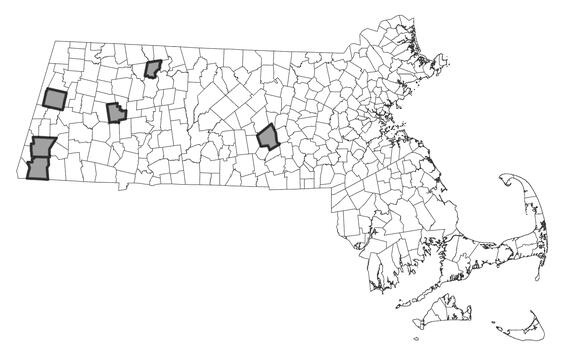- Scientific name: Elymus villosus
- Species of Greatest Conservation Need (MA State Wildlife Action Plan)
- Endangered (MA Endangered Species Act)
Description
Hairy wild rye (Elymus villosus) is a velvety, perennial, tufted grass (family Poaceae) of floodplain forests, rich moist thickets, and rocky woodlands. Just over a meter in height, this grass is most easily recognized by the dense, whitish “villous” pubescence of its bristly “bottle-brush” inflorescence and leaves.
Grasses have vegetative and reproductive structures unique to the Poaceae family that are vital to identifying plants in any of the several genera. Characteristics of the vegetative morphology, as well as those of the inflorescence, must be examined to determine the species identification; often a hand lens and a technical key are required. The inflorescence (spike or panicle) comprises spikelets, the basic flowering unit of grasses. Each spikelet is subtended by two basal glumes (reduced leaves). Individual florets consist of the lemma (lower or outer bract), the palea (upper or inner bract), and the single flower that is made up of the familiar reproductive structures (e.g., ovary, anthers). The grass fruit (a caryopsis or grain) is a dry, indehiscent, single-seeded fruit.
Notable vegetative characters of hairy wild rye include evenly distributed dark green leaf blades (4-12 mm; 0.16-0.47 in wide) with densely villous upper surfaces. The inflorescence, which is also conspicuously villous, is often arching. The spikelets are tightly arranged within the spike, with little space between them. Each spikelet has 1 or 2 florets. The glumes and lemmas have awns that are straight (not arching) at maturity. The glumes have a roundish, hardened base, and are persistent (i.e., they remain on the plant after fruit dispersal). Mature florets of hairy wild rye are present throughout much of the summer.
Other species of Elymus in Massachusetts can occupy similar habitats; several are superficially similar (dense spikes, appressed spikelets, and relatively long glumes), but can be differentiated with close examination.
Canada wild rye (E. canadensis) and Wiegand’s rye (E. wiegandii) both have spikelets with awns that arch at maturity, and glumes that are flattened basally. Further, Canada wild rye has hairs that are more coarse and appressed than the soft, whitish, velvety pubescence of hairy wild rye. Riverbank wild rye (E. riparius) has spikelets and foliage that are glabrous or scabrous, but not villous. Lastly, early wild wry (E. macgregorii) and Virginia wild rye (E. virginica) have erect (rather than arching) spikes and glumes that are less bristle-like and more flattened at the base than those of hairy wild rye.
Life cycle and behavior
This is a perennial grass.
Population status
Hairy wild rye is listed under the Massachusetts Endangered Species Act (MESA) as endangered. All listed species under MESA are protected from killing, collecting, possessing, or sale and from activities that would destroy habitat and thus directly or indirectly cause mortality or disrupt critical behaviors. The MassWildlife’s Natural Heritage & Endangered Species Program has 7 records from 5 counties: Berkshire, Essex, Franklin, Hampshire, and Worcester. Five of these records have been observed within the last 25 years.

Distribution in Massachusetts. 1999-2024. Based on records in the Natural Heritage Database.
Distribution and abundance
Hairy wild rye is known from parts of eastern and central Canada (i.e., Ontario, Quebec), and from much of the eastern and midwestern states, excluding Maine, New Hampshire, Florida, and Louisiana. The range of hairy wild rye extends westward to North Dakota, Wyoming, Colorado, and New Mexico.
Habitat
In Massachusetts, hairy wild rye inhabits high terrace floodplain forests with moist alluvial soils and moist to dry, rich, rocky open woods and thickets. Along floodplain terraces, associated native species include silver maple (Acer saccharinum), green ash (Fraxinus pennsylvanica), basswood (Tilia Americana), hackberry (Celtis occidentalis), bladdernut (Staphylea trifolia), wood-nettle (Laportea canadensis), and ostrich-fern (Matteuccia struthiopteris). In rich rocky woodlands, associates include sugar maple (Acer saccharum), red oak (Quercus rubra), white wood aster (Eurybia divaricata), bluestem goldenrod (Solidago caesia), and blackseed ricegrass (Piptatherum racemosum).
Healthy habitats are vital for supporting native wildlife and plants. Explore habitats and learn about conservation and restoration in Massachusetts.
Threats
Threats to hairy wild rye include water withdrawals that curtail flooding on floodplains, dikes and other infrastructure that disconnect floodplains from streamflows, and invasive species.
Conservation
The exact management needs of hairy wild rye are not known. As with all species, however, maintaining habitat quality is essential. Many of the current populations in the state are found in high terrace river floodplain forests, which are flooded periodically. Thus, changes to the hydrologic regime due to local use could reduce habitat suitability and threaten the viability of a hairy wild rye population. Hairy wild rye habitat should be monitored for exotic invasive species. Invasive plants can out-compete native plants for nutrients and light, excluding them over time.
Some of the exotic species that occur in hairy wild rye habitat include garlic mustard (Alliaria petiolata), reed canary grass (Phalaris arundinacea), Dame’s rocket (Hesperis matronalis), Japanese barberry (Berberis thunbergii), common buckthorn (Rhamnus cathartica), multiflora rose (Rosa multiflora), Oriental bittersweet (Celastrus orbiculatus), and Morrow’s honeysuckle (Lonicera morrowii). If exotic plants are invading hairy wild rye habitat, a plan for control should be constructed. All active management within the habitat of a rare plant population (including invasive species removal) is subject to review under MESA and should be planned in close consultation with the MassWildlife’s Natural Heritage & Endangered Species Program.
Contact
| Date published: | May 7, 2025 |
|---|